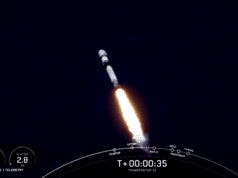SpaceX has launched a satellite for Inmarsat that gives the operator more capacity for partnerships in an emerging direct-to-device market.
A Falcon 9 carrying the British company’s Inmarsat-6 F2 (I-6 F2) satellite lifted off 10:59 p.m. Eastern from Cape Canaveral Space Force Station, Florida.
I-6 F2 separated from the rocket about 32 minutes later, and will use onboard electric propulsion to get to its geostationary orbit slot over the Atlantic Ocean over the next several months.
The rocket’s first stage successfully landed shortly after launch for reuse. The booster has previously supported a crewed flight to the International Space Station and the launch of a GPS 3 satellite.
Inmarsat said I-6 F2 is slated to enter service in 2024 following rigorous in-orbit tests.
Both Airbus-built satellites are equipped with a hybrid Ka-band and L-band payload to primarily provide mobile connectivity services across maritime, aviation, and government markets.
I-6 F1’s Ka-band capacity will target demand for high-speed connectivity in Southeast Asia, Inmarsat chief technology officer Peter Hadinger said, while I-6 F2’s Ka-band beams will address hotspots over the Atlantic Ocean.
According to Hadinger, each satellite also doubles the amount of usable L-band capacity in their coverage area that Inmarsat currently provides with its eight-satellite global ELERA network.
This step-up in capacity will primarily support the voice and messaging services Inmarsat already enables via specialized handsets with bulky antennas, as well as its business for connecting remote tracking and monitoring devices.
“It certainly gives us longevity,” he said, referring to how each satellite is designed to operate for more than 15 years.
“And by giving us additional efficiency in the spectrum, it does improve the number of options we have in terms of lining up with any of these particular direct-to-device” initiatives.




